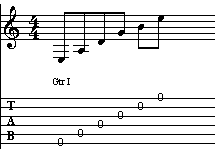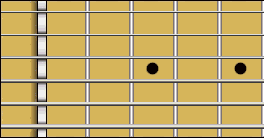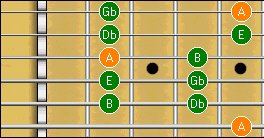free ultimate guitar lessons | tabs - basics
While not meant to replace standard reading notation skills, the ability to read it's simpler cousin - "Guitar Tablature" (or tab as it's known), has it's advantages to say the least. Designed for simplicity and handy for many players to know the basics. Many Tab books are available today ranging in accuracy from awful to note-for-note - beware and get a gud 'un is my advice - pay a little extra if you must, it's worth it.
For many reasons, reading and writing music does give you huge advantages though eg quickly learning and playing other people's music, and not necessarily guitar music either. For example you can pick up some fine tips by reading other players music such as found in Saxophone, Violin and Piano scores. So it's worth seriously considering to learn this skill, if you don't have and use it already.
But here we are looking at this handy learning tool of guitar tablature, which is to be found frequently on the 'Net - "but u pays for what u git's" as they say. Free ain't always best ;-) in this case.
* Beginner's Tab Tip Use a piece of music written in tab alongside it's recording, to get accurate timing quickly - but most importantly use your ear as well. Tab's written down (like standard notation) are not error free sometimes, and can be wrong! This will make a huge positive learning difference.
So here's the basics and off we go...
Tablature Basics
Unlike conventional music notation, where the lines have no direct relationship with the strings, the 6 tablature lines do represent the actual strings of the guitar.
A simple Guitar Tablature can often have the conventional standard notation equivalent represented above it, looks like this -

Sometimes the tab itself has the rhythm notes written directly on the Tab Staff itself - The basic system is the same as shown here.
Here's the notes of the guitar if you played just the open (unfretted) strings one after the other, with a simple standard note equivalent on top -

Here's what the above empty guitar tablature looks like and is equal to in the real world:

To write (or read) notes in Tab, you simply write in a number on a string, which corresponds to which fret should be played. For example a number 3 on the hi-E string means exactly that - play the hi E string fretted at the 3rd fret. Let's add a scale to see what it looks like.
Easy huh?
Here's an A Major Pentatonic scale in guitar tablature form - great for country and loads of other styles.

And here's the real world version -

If you want to write or learn a chord, or a few notes simultaneously, just stack them beside each other like this - here's a common garden-variety G chord written in Tab -

It helps a whole lot if you learn basic rhythm notation - there's not many.
Basically be familiar with counting whole notes, half, quarter, eights, sixteens and 32's, 64s, (the ones you use), and that will serve you well for the moment.
Here are the basic counts used in music - try clapping your hands on the underlined notes while keeping your foot tapping a constant 1 2 3 4 ... slowly at first if your new to it.
* Whole Note:
* Half Note:
* Quarter Note:
* Eight Note:
* Triplet Note:
* Sixteenth Note:
* Count = 1 (-) (-) (-) 2...
* Count = 1 (-) 3 (-) 2...
* Count = 1 2 3 4 2...
* Count = 1 +2 +3 +4 +2...
* Count = 1 e a 2 e a 3... (or 1 trip-let 2...)
* Count = 1 e + a 2 e + a 3 e + a 4 ...
This vital and basic counting skill/tool can improve anyone's (genius' aside ;) musical ability. A thorough grounding in the counting basics to the uninitiated can shave years off the learning process.
Embellishments
Don't forget that any of the notes written in Tab (like Standard Notation), can be further embellished with further helpful signs, such as H for hammer the note, P means a pull-off and so on. A good Tab book will explain them all to you at the start of the tutor. They are easy to learn and instantly recognize-able - here's a quick example of how a hammer-on would be written -

You play the D string on the second fret, and hammer on to the fourth fret.
If hammer ons and pull-offs are alien to you, and you want to learn about them, get yourself that basic primer to fill in the gaps.
Good Tab also gives you the necessary rhythm pattern which are written down along with the notes or chords themselves. It get's easier to learn the written rhythms if you practice and use the system regularly. I would recommend about 1/2 an hour reading a day and before you know it you'll have no problems reading most pieces.
But what if you don't have years of music reading or indeed any, under your belt and you're in a quick hurry?
Well that's where you can use another method to pick up the rhythm, and one that I think is an even stronger way to do it - Listen to the record or piece of music alongside with studying the guitar tablature. You're given the correct notes to play and they are easy enough to learn, but take the phrasing and timing off the audio of the piece you're learning.
This gives you that vital ear training, which no amount of reading can achieve. Also strongly recommended is good old fashioned "ear to the speaker and work out the notes yourself". This I believe is still the most potent method to learn and train your "musical ear".
Build Strong Music Foundations
If you want speed and strong music foundations to build on, I suggest that you learn these type of basics as fast as possible. You can absorb them over days, weeks months or even years!
Regarding the old debate about whether it is a necessary fundamental to be able to read and write Standard Notation music fluently to be taken as a "serious musician", I'm on the side of the fence that agrees that's it's not a basic requirement. I'm not saying that you shouldn't learn how to read music, but sometimes it is not a necessary skill to learn and possess for a student or player of the guitar. You could ask Sir Paul McCartney on that one if you can get hold of him! ;-).
If he's not available, maybe another non-reader can shed some light on the subject - A certain Mr. Edward Van Halen doesn't read or need a note.
Better not ask a super transcriber and reader like Steve Vai or his ilk ;-).
I think that being able to read standard notation certainly is a big plus, if not an indispensible tool for SOME players, but not all.
When classical music was at it's height a few hundred odd years ago, Standard Notation was a must because there was no other way to record what a person had composed. But nowadays, a lot of popular and excellent music doesn't require it - the times they are a' changin' as the man said.
Especially in Pop music at the moment, where the charts are filled with what I would call more "entertainers" as opposed to "musicians". I can't imagine many of today's media artists slaving over a score to learn it - they're too busy putting on their make-up ;-). Although I remember Glam Rocker's in the 70's too... hmmm.
I wouldn't think music notation skills are a requirement for a band like U2 or Coldplay, but many hot players like Jeff Berlin, Steve Vai and many more, strongly recommend that you do learn it. I suppose it's up to you and the type of music you want to play. Personally I listen to many artist's which I consider to be my faves, and some can read 'n' write but some can't read a note, and don't need to either to make great music.
Two examples for me would be The Beatles in the non-readers camp (although schooled musician George Martin played a huge part in their music I feel), and say Beethoven in the other - I love listening to both of their works ;-).
Either way, a knowledge of Guitar Tablature is a handy quick learning tool to possess.
See you and thanx - hope you enjoyed and picked up something useful from this quick Tab Basics Intro.
For many reasons, reading and writing music does give you huge advantages though eg quickly learning and playing other people's music, and not necessarily guitar music either. For example you can pick up some fine tips by reading other players music such as found in Saxophone, Violin and Piano scores. So it's worth seriously considering to learn this skill, if you don't have and use it already.
But here we are looking at this handy learning tool of guitar tablature, which is to be found frequently on the 'Net - "but u pays for what u git's" as they say. Free ain't always best ;-) in this case.
* Beginner's Tab Tip Use a piece of music written in tab alongside it's recording, to get accurate timing quickly - but most importantly use your ear as well. Tab's written down (like standard notation) are not error free sometimes, and can be wrong! This will make a huge positive learning difference.
So here's the basics and off we go...
Tablature Basics
Unlike conventional music notation, where the lines have no direct relationship with the strings, the 6 tablature lines do represent the actual strings of the guitar.
A simple Guitar Tablature can often have the conventional standard notation equivalent represented above it, looks like this -

Sometimes the tab itself has the rhythm notes written directly on the Tab Staff itself - The basic system is the same as shown here.
Here's the notes of the guitar if you played just the open (unfretted) strings one after the other, with a simple standard note equivalent on top -

Here's what the above empty guitar tablature looks like and is equal to in the real world:

To write (or read) notes in Tab, you simply write in a number on a string, which corresponds to which fret should be played. For example a number 3 on the hi-E string means exactly that - play the hi E string fretted at the 3rd fret. Let's add a scale to see what it looks like.
Easy huh?
Here's an A Major Pentatonic scale in guitar tablature form - great for country and loads of other styles.

And here's the real world version -

If you want to write or learn a chord, or a few notes simultaneously, just stack them beside each other like this - here's a common garden-variety G chord written in Tab -

It helps a whole lot if you learn basic rhythm notation - there's not many.
Basically be familiar with counting whole notes, half, quarter, eights, sixteens and 32's, 64s, (the ones you use), and that will serve you well for the moment.
Here are the basic counts used in music - try clapping your hands on the underlined notes while keeping your foot tapping a constant 1 2 3 4 ... slowly at first if your new to it.
* Whole Note:
* Half Note:
* Quarter Note:
* Eight Note:
* Triplet Note:
* Sixteenth Note:
* Count = 1 (-) (-) (-) 2...
* Count = 1 (-) 3 (-) 2...
* Count = 1 2 3 4 2...
* Count = 1 +2 +3 +4 +2...
* Count = 1 e a 2 e a 3... (or 1 trip-let 2...)
* Count = 1 e + a 2 e + a 3 e + a 4 ...
This vital and basic counting skill/tool can improve anyone's (genius' aside ;) musical ability. A thorough grounding in the counting basics to the uninitiated can shave years off the learning process.
Embellishments
Don't forget that any of the notes written in Tab (like Standard Notation), can be further embellished with further helpful signs, such as H for hammer the note, P means a pull-off and so on. A good Tab book will explain them all to you at the start of the tutor. They are easy to learn and instantly recognize-able - here's a quick example of how a hammer-on would be written -

You play the D string on the second fret, and hammer on to the fourth fret.
If hammer ons and pull-offs are alien to you, and you want to learn about them, get yourself that basic primer to fill in the gaps.
Good Tab also gives you the necessary rhythm pattern which are written down along with the notes or chords themselves. It get's easier to learn the written rhythms if you practice and use the system regularly. I would recommend about 1/2 an hour reading a day and before you know it you'll have no problems reading most pieces.
But what if you don't have years of music reading or indeed any, under your belt and you're in a quick hurry?
Well that's where you can use another method to pick up the rhythm, and one that I think is an even stronger way to do it - Listen to the record or piece of music alongside with studying the guitar tablature. You're given the correct notes to play and they are easy enough to learn, but take the phrasing and timing off the audio of the piece you're learning.
This gives you that vital ear training, which no amount of reading can achieve. Also strongly recommended is good old fashioned "ear to the speaker and work out the notes yourself". This I believe is still the most potent method to learn and train your "musical ear".
Build Strong Music Foundations
If you want speed and strong music foundations to build on, I suggest that you learn these type of basics as fast as possible. You can absorb them over days, weeks months or even years!
Regarding the old debate about whether it is a necessary fundamental to be able to read and write Standard Notation music fluently to be taken as a "serious musician", I'm on the side of the fence that agrees that's it's not a basic requirement. I'm not saying that you shouldn't learn how to read music, but sometimes it is not a necessary skill to learn and possess for a student or player of the guitar. You could ask Sir Paul McCartney on that one if you can get hold of him! ;-).
If he's not available, maybe another non-reader can shed some light on the subject - A certain Mr. Edward Van Halen doesn't read or need a note.
Better not ask a super transcriber and reader like Steve Vai or his ilk ;-).
I think that being able to read standard notation certainly is a big plus, if not an indispensible tool for SOME players, but not all.
When classical music was at it's height a few hundred odd years ago, Standard Notation was a must because there was no other way to record what a person had composed. But nowadays, a lot of popular and excellent music doesn't require it - the times they are a' changin' as the man said.
Especially in Pop music at the moment, where the charts are filled with what I would call more "entertainers" as opposed to "musicians". I can't imagine many of today's media artists slaving over a score to learn it - they're too busy putting on their make-up ;-). Although I remember Glam Rocker's in the 70's too... hmmm.
I wouldn't think music notation skills are a requirement for a band like U2 or Coldplay, but many hot players like Jeff Berlin, Steve Vai and many more, strongly recommend that you do learn it. I suppose it's up to you and the type of music you want to play. Personally I listen to many artist's which I consider to be my faves, and some can read 'n' write but some can't read a note, and don't need to either to make great music.
Two examples for me would be The Beatles in the non-readers camp (although schooled musician George Martin played a huge part in their music I feel), and say Beethoven in the other - I love listening to both of their works ;-).
Either way, a knowledge of Guitar Tablature is a handy quick learning tool to possess.
See you and thanx - hope you enjoyed and picked up something useful from this quick Tab Basics Intro.


0 Comments:
Post a Comment
<< Home